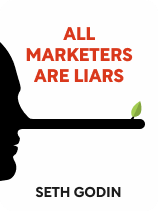

This article is an excerpt from the Shortform book guide to "All Marketers are Liars" by Seth Godin. Shortform has the world's best summaries and analyses of books you should be reading.
Like this article? Sign up for a free trial here .
What impression do you make on your customers? Do you make them want to engage further?
Customers filter information through their worldview. This tendency to make quick, lasting judgments means it’s important to make a good first impression with your product and company. It’s important to distinguish first encounters from impressions, to know how to make a good impression, and to understand the power of personal connection.
Read on to learn how to impress customers.
Impressions vs. Encounters
A customer’s first encounter is their initial introduction to your product. They may walk into your store on a whim or click on your website by accident. However, the first encounter may not cause them to engage with your story. And if it doesn’t engage them, they’ll disregard their first encounter as they interact with other options in the marketplace.
In contrast, Godin contends that when you learn how to impress customers, you can successfully grab the customer’s attention in an encounter and create an impression that leads them to make a snap judgment about your idea or product.
That’s why first impressions are so important for a marketer—it’s your best (and sometimes only) opportunity to get through to a customer. Consider these two examples showing how first impressions work:
- An undecided voter receives a flyer about a political candidate, dismisses a phone call from a canvasser, and drives by a local rally for the candidate. They don’t think much about the candidate until they see a social media post from the candidate that resonates with their worldview, causing them to pay more attention to the campaign.
- Jeff visits a farmers’ market every Saturday to buy local produce. He hasn’t found a favorite stall, so he alternates among vendors each week, usually depending on the length of the checkout line. One week, a vendor lets someone else skip ahead of Jeff in line, causing him to feel unseen and unappreciated. This leaves a bad impression on Jeff, and now he subconsciously avoids this vendor.
The 2 Keys to Making a Good Impression
Since not every encounter will turn into an impression, the best you can do as a marketer is make sure that no matter what encounter a customer has, it’s a good one. That way, when an encounter does eventually make an impression on them (and Godin assumes that an impression will happen eventually), it’ll be a favorable one. He thinks to ensure good encounters (and by extension, good impressions), every way you incorporate your story should be perfect—or as close as you can get.
If you can’t be sure which encounter with your product will create a first impression on a customer, how do you incorporate your story perfectly to get through in a favorable way? Godin believes being authentic and telling a cohesive story are the keys to creating good impressions.
| Choose Color Carefully What factors affect a potential customer’s impression of your product? Color plays a big role in unconscious thinking. In a 2006 study, researchers discovered that up to 90% of snap judgments about products are based on color. Your choice of color can influence mood, appetite, and even perception of time spent waiting. Green is often associated with growth and nature, and red is often associated with aggression or an increase in appetite. However, not everyone experiences color the same way. Gender and nationality are two factors that influence response to color. Consider your target audience and what your colors might be saying to them. In Alexandria Ocasio-Cortez’s 2018 congressional campaign, she used purple to represent red and blue (colors associated with right and left) coming together. Her designer also used yellow to convey optimism and blue for the Democratic Party. This color scheme helped her stand out from traditional political campaigns that generally use red, white, and blue. |
Be Authentic
Godin recommends telling a story that aligns with your company, the product itself, and brand identity. This could be a story about luxury, family, beauty, or comfort—just be sure this story is true to the overall ethos of your idea and brand.
For example, French brand Louis Vuitton makes luxury handbags and apparel that retail for thousands of dollars. They’ve built their brand around exclusivity and luxury. The brand never offers sales or discounts, and it doesn’t have an outlet store. This approach reinforces their image as an exclusive brand. If Louis Vuitton decided to offer a discount to bring in more sales, it would be inauthentic to the ethos of the company.
| How to Be Authentic Throughout the book, Godin stresses the importance of being authentic in your marketing. There are a few things you can do to create more authentic advertising campaigns. In Purple Cow, Godin says you should be passionate about your idea or product. This will make your idea and your story more contagious because you’ll naturally be able to tell consumers about what kind of value your product can add to their life. If you’re not already passionate about a product you’re working on, try to understand it from the perspective of someone who already loves it. You can also try advertising icon David Ogilvy’s advice: Use the product. This puts you in the consumer’s shoes and helps you understand the benefits of your product. |
Be Cohesive
It’s important to make all elements of your branding cohesive to account for all of the possible ways people encounter your product. Your story should be part of all aspects of your brand. Godin says every department is part of marketing. If the president of your favorite company used a competitor’s products, would that change your perception of their products?
Because you don’t know whether a customer’s first (or second or third) encounter will be their first impression, it’s best to cover your bases and incorporate your authentic story into every possible encounter. If you tell an authentic story across all potential encounters, you’re more likely to make a good first impression.
Let’s say you’re applying for a new job. The image you present to the hiring manager should be authentic (while still professional) and highlight the skills you actually bring to the table (you shouldn’t lie about having skills you don’t have). However, you should make the presentation of this image consistent throughout the design of your resumé, language in your cover letter, the kinds of pictures you post on your social media profiles, email correspondence with the hiring manager, and clothes you wear to the interview. Having a cohesive story will increase the likelihood that the hiring manager’s first impression of you (whether that occurs from your emails, resume, outfit, or interview) is one that you intended to portray.
| Create a Marketing Plan In Godin’s view, your goal in marketing is to turn strangers into friends and friends into customers. To turn strangers into customers, try making a marketing plan. In The 1-Page Marketing Plan, Allan Dib attributes the failure of most small businesses to their lack of a marketing plan, and he outlines how to make a plan. His method can be broken down into three phases: Awareness: This is where you make prospects (or strangers) aware of your product and generate interest. Do this by identifying your target audience, developing the message you’ll tell that audience, and figuring out what medium you’ll use to tell them that story. Familiarity: This deals with leads (or friends) who have taken an interest in your product. They’ve taken some sort of action, like signing up for email notifications or putting a product in their cart, to indicate interest. Get your lead’s contact information into a database, deliver value, and build their trust. Enthusiasm: This is when your leads become customers. They’ve bought your product. You want to build their enthusiasm so 1) they’ll keep purchasing from you, and 2) they’ll tell their friends. Give them an extraordinary experience. |
The Power of Personal Connection
Suppose you tried to be authentic and cohesive with your story, but your customer had a bad first impression—maybe they were in a bad mood that day, or you said the wrong thing in your interview. What should you do? If you’ve left a bad first impression with a customer, the best remedy is genuine personal interaction, in which a customer can openly communicate with you or a person from your company.
Godin believes personal interactions are the best way to foster authentic relationships with customers. This could come from a recommendation from a friend, a pleasant interaction with an employee, or a friendly phone call. He recommends you ditch the script and connect with your customers. Good personal interactions cut through the gimmicks and create lasting impressions.
| Make It Personal Let’s look at two ways to make your marketing more personal: customer service and influencer sponsorships. In Raving Fans, Ken Blanchard and Sheldon Bowles describe how creating better customer service experiences can help companies succeed. They say the key to happy (not just satisfied) customers is through this five-step plan: Define your ideal customer service experience, discover your customer’s ideal experience, integrate your vision with their needs, build an effective and consistent system, and always exceed customer expectations. Since the publication of this book in 2005, marketing has seen even more opportunities to connect with consumers, mainly through social media. Marketers have tapped into the power of personal interaction by advertising through influencer sponsorships. Consumers will follow social media influencers because they like an influencer’s content. When influencers recommend products, their followers are more likely to try those products because they trust the influencer or share the influencer’s worldview. Many brands work with influencers so they can add a personal touch to their marketing. |

———End of Preview———
Like what you just read? Read the rest of the world's best book summary and analysis of Seth Godin's "All Marketers are Liars" at Shortform .
Here's what you'll find in our full All Marketers are Liars summary :
- The difference between lying and telling a great story
- How to better understand your customer
- How to overcome common obstacles you’ll encounter in marketing






